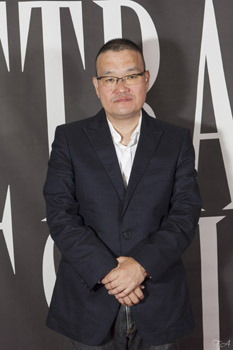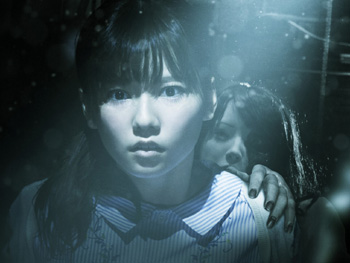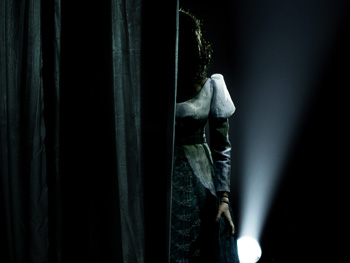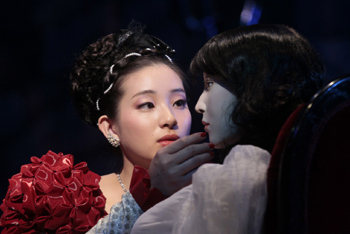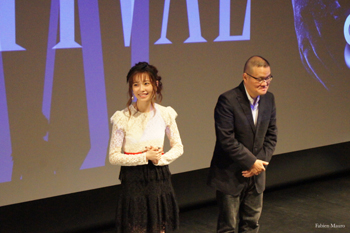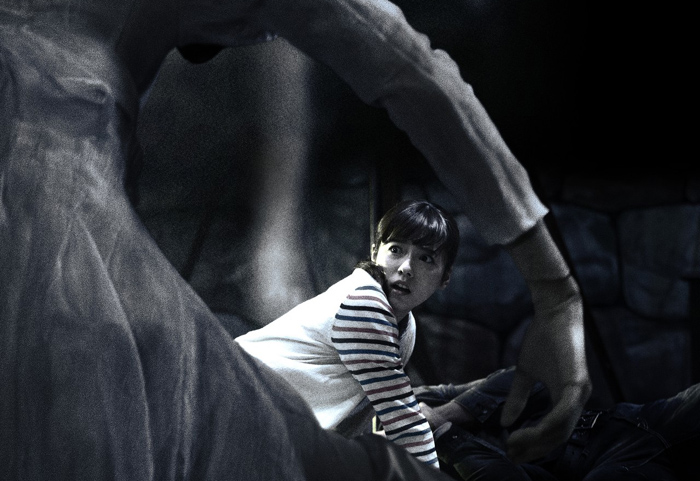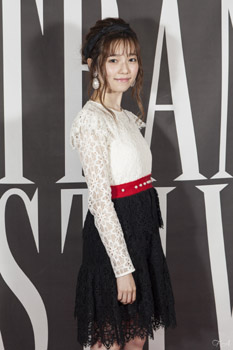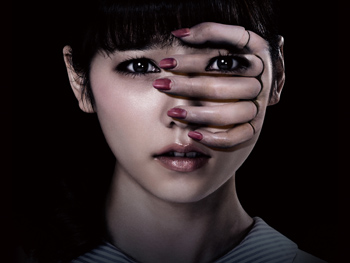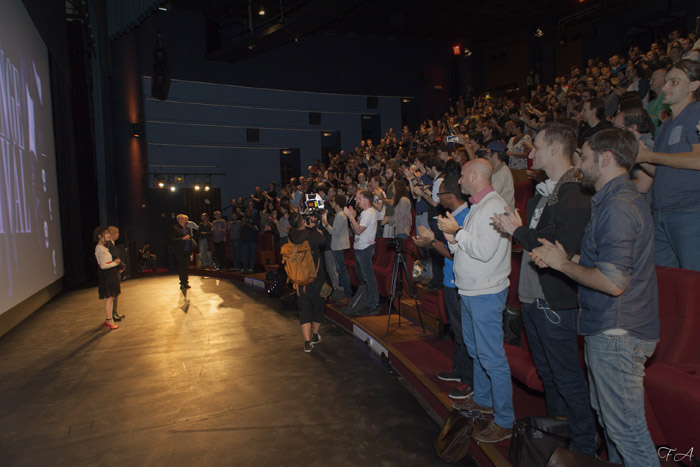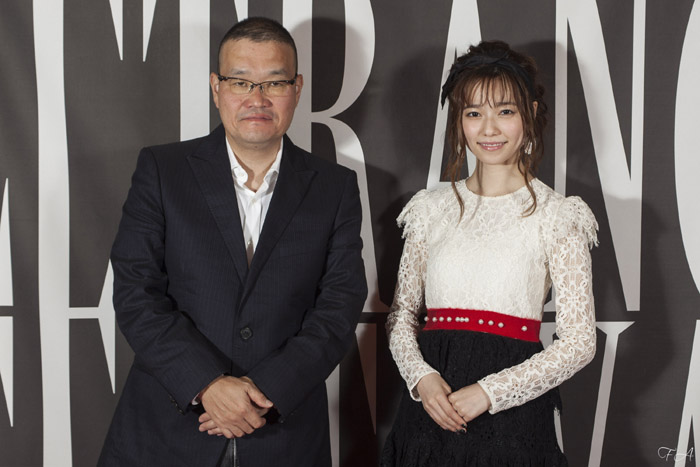 Director Hideo Nakata and actress Haruka Shimazaki at the world premiere of their new Japanese horror film, GHOST THEATER. Photo courtesy of Frédéric Ambroisine.
Director Hideo Nakata and actress Haruka Shimazaki at the world premiere of their new Japanese horror film, GHOST THEATER. Photo courtesy of Frédéric Ambroisine.Interviewer: Fabien Mauro Translator: Shoko Takahashi L’Étrange Festival Official Website: etrangefestival.com/2015 (English) Official Movie Site: gekijourei.jp (Japan) Special Thanks to Hideo Nakata, Haruka Shimazaki, Xavier Fayet & Estelle Lacaud, Frédéric Ambroisine J-Horror master Hideo Nakata (THE RING 1 & 2, DARK WATER) and singer/actress Haruka Shimazaki from AKB48 attended the World Premiere of GHOST THEATER (???, Gekijourei) on September 11th at the 21st édition of L’Étrange Festival at Le Forum des Images in Paris. This film is an update of Nakata`s 1996 movie, GHOST ACTRESS (???, Joyuurei, aka DON`T LOOK UP). Nakata-san and Shimazaki-san were welcomed by a standing ovation in a packed screening room. The director and the star share some secrets about the film, which will be released in Japanese theaters on November 21.
HIDEO NAKATA
Fabien Mauro: Twenty years after GHOST ACTRESS, why did you choose to reinvent this story? Hideo Nakata: At the beginning, Yasushi Akimoto, producer of J-pop band AKB48, liked GHOST ACTRESS very much. But he wanted to transpose the story from a movie shooting to the rehearsals of a stage play. The project started there. Fabien Mauro: In GHOST THEATER, the spirit of a dead woman comes back in the form of a doll, which is a physical object. Is it a way to update the image of the Japanese ghost? Hideo Nakata: Yes, it was my intention. I’ve been making horror movies for almost twenty years. I wanted to bring innovation to the formula. In most of Japanese movies, ghosts are represented as blurry apparitions. They don’t physically exist but we can still see them. I was often told about it. As a director, I thought it would be difficult to keep my passion if I had to show the same ghosts again and again. We had to bring new ideas. This time, I wanted to bring a tangible item, which exists in the material reality. The soul of the dead person has to go into that item. That’s why the doll starts to move. The limbs and eyes come to life. It becomes a kind of monster. Fabien Mauro: This doll has jerky and dislocated movements. Did you work with a dancer as you did with THE RING? Hideo Nakata: In THE RING, the person who played Sadako [Rie Ino] was a true stage actress. She practiced bûto, a Japanese dance. She had unique physical predispositions to create those movements. When she comes off the TV screen, she crawls like a normal person. But when she gets out of the well her movements become truly disturbing. It was an efficient process to get those unusual gestures. In GHOST THEATER, the actress who plays the doll comes from classical ballet. But she went into intense training to prepare for the role. This training was supervised by a pantomime expert. I asked the actress to come with movements at the crossroads between a mime and a puppet. You can see the result in the movie. Fabien Mauro: Could you tell about your collaboration with your main actress, Haruka Shimazaki?
Hideo Nakata: When I was searching for an actress to play Sara, I had to organize auditions with the hundred girls of the AKB48 band. I finally chose Haruka Shimazaki. I was convinced she would be perfect as Sara. I knew she didn’t have a lot experience as an actress, but she practiced a lot so she made a lot of progress. We had a month and a half of shooting. I think to play a movie heroine, and not only in horror movies, the actress has to project a true "cinematic photogenicy". I thought Shimazaki-san had this quality. And my intuition was strengthened during shooting. To come back on this idea of cinematic photogenicy, the face and look of the actress are very important, especially when she has to open wide her eyes to express fear. She was able to transcribe those expressions onscreen. Fabien Mauro: Like the leading ladies of THE RING, DARK WATER or THE COMPLEX, Sara meets the ghosts and investigates about their past. Your cinema always shows proactive female characters. Hideo Nakata: In THE RING, there is this video that shows strange and mysterious pictures, with letters and pieces of newspapers moving. It leaves clues for the characters to understand the mystery. This is an element I would not qualify as essential but important in this kind of movies where the female characters must investigate about the past. When I was working on the plot of GHOST THEATER, I wasn’t sure to put this element. But in the end, I couldn’t help to bring it into the story. But the resolution of a mystery became recurrent in those films. Fabien Mauro: The movie shows the point of view of the aggressor who attacks the victims. Did you want to break the famous "Konaka Theory"1 by changing your directing style?
Hideo Nakata: Imagine a situation where the main character faces the ghost. You can consider many ways to shoot your scene. The first solution is to put the camera at the level of the killer to show the victim screaming. But this choice means those two characters are on the same level. Acording to Chiaki J. Konaka, the impact is reduced and it’s not scary. The other possibility is to put the camera at the level of the ghost`s field of view to have a clear vision of the victim. That’s not really the eye vision, but some kind of shifted perspective. I often used this approach on THE RING. On GHOST THEATER, we used the hands of the doll to show their point of view in a way. But a doll is not a ghost. It’s an inert item that comes to life. We had to feel its vision and feelings. So, using the point of view of a moving object can be scary. Fabien Mauro: With THE COMPLEX and GHOST THEATER, you experiment with colors. It calls to mind horror master Nobuo Nakagawa as well as Italian moviemakers like Mario Bava and Dario Argento. Hideo Nakata: For GHOST THEATER, I studied the films of Dario Argento a lot, especially SUSPIRIA and INFERNO. I analyzed his way to use colors, especially red and green. We used many color filters. GHOST THEATER can easily be seen in the tradition of those European gothic movies. This was my intention. Nobuo Nakagawa was also an inspiration for color. When you watch GHOST STORY OF YOTSUYA [1959], you see red is very present in the picture. I did not want to imitate those people, but I was inspired by them to try new experiments. In THE COMPLEX, I used green a lot. I think if I made such a use of lights and colors for THE RING, it would not have worked. But nowadays, I think we need to emphasize, and sometimes to exaggerate, our effects. Fabien Mauro: The characters are making rehearsals for a play about countess Elizabeth Báthory. Did you want to create a kind of "Droste Effect" of this character by using a doll that feeds on the living essence of the victims? Hideo Nakata: I’m try to collect my memories of the writing process (laughs). At one point, we decided the story had to be set in a theater. We thought it was not interesting if the ghosts only appear on stage. So, we decided to use a doll slightly taller than a human being. This doll feeds on human flesh and blood. With this idea, we decided to bring the story of countess Elizabeth into the play. For the theater sequences, I specifically asked for a female stage writer and director to come. I asked her to supervise the work on the rehearsals for those sequences.
Fabien Mauro: Would you like to make a true gothic movie in the years to come? Hideo Nakata: I would like to direct a movie with some gothic elements. But if I make a fully gothic movie, it would be complicated because there are a lot of western masters who transcended the genre. I don’t think it would work with me. Fabien Mauro: The identity of the ghost is also designed by a lot of creaking. Let’s talk about the sound design of the movie. Hideo Nakata: The creation of sound design is specific. For the music, I worked with many people by the past. But since THE RING, I only work with Kenji Kawai. For the sound effects, I asked Kenji Shibasaki. He worked on most of Takashi Miike’s movies. He’s one of the best sound designers in Japanese cinema. We worked a lot on the sounds made by the doll, especially when it climbs the stairs. There is a scene where it opens the curtain and walks towards the art director’s assistant. In this sequence, the blending of music and sounds is extremely important. Most of the time, sound effects were considered as most important than the music, but sometimes it was the opposite. We needed to find the right balance to make it work. But in those cases, there is no rule of theory. You feel like an orchestra conductor who has to find the perfect harmony between sound and music. To design the creaking of the doll, Kenji Shibasaki chose the right items and instruments himself. Fabien Mauro: Following the example of THE RING and DARK WATER, GHOST THEATER gives a great importance to water in the tragedy of the ghosts. What is the symbolic function of water in your movies?
Hideo Nakata: In THE RING, there is dialogue that mentions the fear of Japanese people towards water. Recently, we had a typhoon in our country. A river overflowed and a whole city was flooded. There were many victims. The Japanese people experience many natural disasters linked to water. The scary element of water is anchored in us. Traditionally, water and ghosts are inseparable. Ghosts are always covered with water. When you look at traditional Japanese paintings, ghosts are always close to banks or lakes. Ghosts are always associated to something humid and aquatic. But the presence of water is also linked to my personal tastes. I like rivers and ponds. I’m not really fascinated by water. But, ever since I was a child, I kept the memory of a river turning brown after a typhoon. I often watched the water currents. As the water is in a perpetual flow, the river always changes shapes. So, I’m very fascinated by the movements of water. Fabien Mauro: Would you like to continue in horror movies or moving into another genre? Hideo Nakata: I don’t necessarily wish to continue in horror movies. Next year, I wish to begin the shooting of a completely different kind of movie. Haruka Shimazaki said the things that scare her the most are human beings. I think she’s right because people can do horrible crimes. The terror is one thing, but cruelty is worse. It’s the basis for thrillers and suspense movies. I think there are subtle borders between fiction and the evil potential of mankind. This is the difference between fantasy and suspense movies. And I would like to go explore the latter. Fabien Mauro: You want to go deep into the dark corners of human soul. Hideo Nakata: Yes. Exactly.
HARUKA SHIMAZAKI
Fabien Mauro: Were you happy to participate in a horror film? What are your favorite horror movies ? Haruka Shimazaki: I started by reading the screenplay, which is a step you can only do by yourself. But I was so scared I just stopped turning the pages (laughs)! I was terrified. I haven’t seen many horror movies. Nevertheless, I saw Nakata-san’s films. When I was a child, I remember watching DARK WATER with my family. Fabien Mauro: Could you talk about your collaboration with Nakata-san ? Haruka Shimazaki: When I met Nakata-san, I was quite scared (laughs)! But then, we started to talk and my fear completely vanished. He’s a very kind person. Fabien Mauro: Your character, Sara, is a young actress in competition with other female colleagues. You had many auditions before becoming a member of AKB48. Was it easier for you to bring your personal experiences into your acting style? Haruka Shimazaki: I’m not into this competitive spirit. Well, I don’t really see myself as in competition with anyone. But I know some people consider me as a rival. Fabien Mauro: You are very appreciated by audiences. Do you think that will make it easier for viewers to feel close with the character of Sara? Haruka Shimazaki: This is a difficult question. It’s true there are many similarities and common points between this character and me. In fact, I hope the viewers will identify with Sara themselves. Fabien Mauro: Sara herself plays many roles in one stage play. I guess you had to work a lot to give life to all those characters.
Haruka Shimazaki: Before filming began, I had many rehearsals for the theater sequences you see in the movie. Fabien Mauro: Like the female leads of THE RING, DARK WATER or THE COMPLEX, Sara meets the evil spirit and investigates into the past. I guess it’s quite rewarding to play an proactive character. Haruka Shimazaki: Personally, I like to know the story of the ghosts. Nakata-san didn’t feel it was necessary to the plot, but those are the parts I like the most. Fabien Mauro: Did you like playing countess Elizabeth for the theater sequences? Haruka Shimazaki: I don’t have a dominant personality so I wasn`t sure I would be able to play those scenes (laughs)! Fabien Mauro: Does acting allow you to explore new grounds as an artist? Haruka Shimazaki: Aside from my acting work, my other activities don’t allow me to reveal who I am to my fans. Working on movies is an opportunity to make them discover a facet of my personality they don’t know. Fabien Mauro: If you were to star in another horror picture, what kind of character or creature would you like to play? Haruka Shimazaki: I really would like to play an Obake, which is a traditional Japanese ghost, because my skin is very white.
NOTES
1. J-Horror charter created in the late eighties by screenwriter Chiaki J. Konaka. There are many rules such as "Do not show the point of view of the ghost" and "Do not show the ghost and a human character in the same shot".
For more information on GHOST THEATER, please see the earlier coverage here on SciFi Japan:


